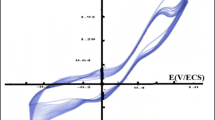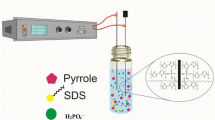Abstract
Water pollution by heavy metals is a great health concern worldwide. Lead and cadmium are among the most toxic heavy metals because they are dangerous for the human and aquatic lives. In this work, the removal of lead and cadmium from aqueous solutions has been studied using electrosynthesized 4-amino-3-hydroxynaphthalene-1-sulfonic acid-doped polypyrrole (AHNSA-PPy) films as a new adsorbent. Two distinct methods, including the immersion method, based on the Pb2+ and Cd2+ spontaneous removal by impregnation of the polymer in the solution, and the electro-elimination method, consisting of removal of Pb2+ and Cd2+ ions from the solution by applying a small electrical current (5 mA) to the polymer film, were developed: the evolution of Pb2+ and Cd2+ concentrations with time was monitored by inductively coupled plasma optical emission spectrometry (ICP-OES). The effect of pH on the adsorption and electro-elimination of Pb2+ and Cd2+ using the AHNSA-PPy film was investigated and optimized, showing that the ionic adsorption and electro-elimination processes were highly pH-dependent. The kinetics of Pb2+ and Cd2+ adsorption and electro-elimination were found to follow second-order curves. The maximum adsorption capacity values of the AHNSA-PPy film were 64.0 and 50.4 mg/g, respectively, for Pb2+ and Cd2+. The removal efficiency values were, respectively, for Pb2+ and Cd2+, 80 and 63% by the immersion method, and 93 and 85% by the electro-elimination method. Application of both methods to Senegal natural waters, fortified with Pb2+ and Cd2+, led to removal efficiency values of, respectively for Pb2+ and Cd2+, 76–77 and 58–59% by the immersion method, and of 82–90 and 80–83%, by the electro-elimination method.






Similar content being viewed by others
References
Altin O, Ozbelge OH, Dogu T (1999) Effect of pH, flow rate and concentration on the sorption of Pb and Cd on montmorillonite. I. Experimental. J Chem Technol Biotechnol 74(12):1131–1138. https://doi.org/10.1002/(SICI)1097-4660(199912)74:12<1131::AID-JCTB158>3.0.CO;2-0
Bhandari H, Choudhary V, Dhawan SK (2011) Influence of self-doped poly(aniline-co-4-amino-3-hydroxy-naphthalene-1-sulfonic acid) on corrosion inhibition behavior of iron in acidic medium. Synth Met 161(9-10):753–762. https://doi.org/10.1016/j.synthmet.2011.01.026
Chauhan D, Jaiswal M, Sankararamakrishnan N (2012) Removal of cadmium and hexavalent chromium from electroplating waste water using thiocarbamoyl chitosan. Carbohydr Polym 88(2):670–675. https://doi.org/10.1016/j.carbpol.2012.01.014
Ćirić-Marjanović G, Trchová M, Matĕjka P, Holler P, Marjanović B, Juranić I (2006) Electrochemical oxidative polymerization of sodium 4-amino-3-hydroxynaphthalene-1-sulfonate and structural characterization of polymeric products. React Funct Polym 66(12):1670–1683. https://doi.org/10.1016/j.reactfunctpolym.2006.07.002
Dabrowski A, Hubicki Z, Podkoscielny P, Robens E (2004) Selective removal of the heavy metal ions from waters and industrial wastewaters by ion-exchange method. Chemosphere 56(2):91–106. https://doi.org/10.1016/j.chemosphere.2004.03.006
Detmar B, Stefan H (1997) Cadmium, gene regulation, and cellular signalling in mammalian cells. Toxicol Appl Pharmacol 144:247–261
Goullé J-P (1998) Métaux. In: Kintz P (ed) Toxicologie et pharmacologie médico-légales. Elsevier, Paris, pp 189–232
Hasani T, Eisazadeh H (2013) Removal of Cd (II) by using polypyrrole and its nanocomposites. Synth Met 175:15–20. https://doi.org/10.1016/j.synthmet.2013.04.026
Heidari A, Younesi H, Mehraban Z (2009) Removal of Ni(II), Cd(II), and Pb(II) from a ternary aqueous solution by amino functionalized mesoporous and nano mesoporous silica. Chem Eng J 153(1-3):70–79. https://doi.org/10.1016/j.cej.2009.06.016
Heidmann I, Calmano W (2008) Removal of Zn(II), Cu(II), Ni(II), Ag(I) and Cr(VI) present in aqueous solutions by aluminum electrolytic treatment. J Hazard Mater 152(3):934–941. https://doi.org/10.1016/j.jhazmat.2007.07.068
Jiang N, Xu Y, Dai LW, Dai L (2012) Polyaniline nanofibers assembled on alginate microsphere for Cu2+ and Pb2+ uptake. J Hazard Mater 215–216:17–24
Jin X, Ling-jun L, Chen W, Xiao-feng W, Wen-yu F, Li-hong X (2008) Lead induces oxidative stress, DNA damage and alteration of p 53, Bax and Bel-2 expressions in mice. Food and Chem Toxicology 46:1488–1494
Just P-E, Chane-Ching KI, Lacroix JC, Lacaze PC (1999) Anodic oxidation of dipyrrolyls linked with conjugated spacers: study of electronic interactions between the polypyrrole chain and the spacers. J Electroanal Chem 479(1):3–11. https://doi.org/10.1016/S0022-0728(99)00420-9
Just P-E, Chane-Ching KI, Lacroix JC, Lacaze PC (2001) Electrochemical oxidation of dipyrrolyl derivatives: application to the formation of reticulated conducting polymers with conjugated spacers. Electrochim Acta 46(20-21):3279–3285. https://doi.org/10.1016/S0013-4686(01)00620-X
Karthik R, Meenakshi S (2015) Removal of Pb (II) and Cd (II) ions from aqueous solution using polyaniline grafted chitosan. Chem Engin J 263:168–177
Kimbrough DE, Cohen Y, Winer AM, Creelman L, Mabuni C (1999) A critical assessment of chromium in the environment. Crit Rev Environ Sci Technol 29(1):1–46. https://doi.org/10.1080/10643389991259164
Lewis TW (1998) A study of the overoxidation of the conducting polymer polypyrrole. Ph D Thesis, University of Wollongong (Australia)
Lyn P (2006) Lead toxicity part II: the role of free radical damage and the use of antioxidants in the pathology and treatment of lead toxicity. Altern Med Rev 11:114–127.
Macchi G, Marani D, Pagano M, Bagnuolo G (1996) A bench study on lead removal from battery manufacturing wastewater by carbonate precipitation. Water Res 30(12):3032–3036. https://doi.org/10.1016/S0043-1354(96)00089-9
Maliyekkal SM, Lisha KP, Pradeep T (2010) A novel cellulose–manganese oxide hybrid material by in situ soft chemical synthesis and its application for the removal of Pb(II) from water. J Hazard Mater 181(1-3):986–995. https://doi.org/10.1016/j.jhazmat.2010.05.112
Mansour MS, Ossman ME, Farag HA (2011) Removal of Cd (II) ion from waste water by adsorption onto polyaniline coated on sawdust. Desalination 272(1-3):301–305. https://doi.org/10.1016/j.desal.2011.01.037
Mortaheb HR, Zolfaghari A, Mokhtarani B, Amini MH, Mandanipour V (2010) Study on removal of cadmium by hybrid liquid membrane process. J Hazard Mater 177(1-3):660–667. https://doi.org/10.1016/j.jhazmat.2009.12.082
Nassar NN (2010) Rapid removal and recovery of Pb(II) from wastewater by magnetic nanoadsorbents. J Hazard Mater 184(1-3):538–546. https://doi.org/10.1016/j.jhazmat.2010.08.069
Novák P, Rasch B, Vielstich W (1991) Overoxidation of polypyrrole in propylene Carbonate. An in situ FTIR Study. J Electrochem Soc 138:3300–3304
Nriagu JO, Pacyna JM (1988) Quantitative assessment of worldwide contamination of air, water and soils by trace metals. Nature 333(6169):134–139. https://doi.org/10.1038/333134a0
Poey J, Philibert C (2000) Toxicité des métaux. Rev Fr Lab 323:35–43
Ramesh ST, Gandhimathi R, Badabhagni N, Nidheesh PV (2011) Removal of Cd (II) from aqueous solution by adsorption onto coir pith, an agricultural solid waste: batch experimental study. Environ Engin Manag J 10:1667–1673
Ramesh ST, Rameshbabu N, Gandhimathi R, Srikanth Kumar M, Nidheesh PV (2013) Adsorptive removal of Pb(II) from aqueous solution using nano-sized hydroxyapatite. Appl Water Sci 3(1):105–113. https://doi.org/10.1007/s13201-012-0064-z
Sall ML, Diaw AKD, Gningue-Sall D, Chevillot-Biraud A, Oturan N, Oturan MA, Aaron J-J (2017) Removal of Cr (VI) from aqueous solution using electrosynthesized 4-amino-3-hydroxynaphthalene-1-sulfonic acid doped polypyrrole as adsorbent. Environ Sci Pollut Res 24(26):21111–21127. https://doi.org/10.1007/s11356-017-9713-y
Sari A, Tuzen M, Citak D, Soylak M (2007) Equilibrium, kinetic and thermodynamic studies of adsorption of Pb(II) from aqueous solution onto Turkish kaolinite clay. J Hazard Mater 149(2):283–291. https://doi.org/10.1016/j.jhazmat.2007.03.078
Satoh M, Kaji T, Tohyama C (2003) Low dose exposure to cadmium and its health effects. Part 3. Toxicity in laboratory animals and cultured cells. Nippon Eiseigaka Zasshi 57(4):615–623. https://doi.org/10.1265/jjh.57.615
Shameem H, Abburi K, Tushar KG, Dabir SV, Veera MB, Edgar DS (2006) Adsorption of divalent cadmium (Cd(II)) from aqueous solutions onto chitosan coated perlite beads. Ind Eng Chem Res 45:5066–5077
Sharma S, Pathania D, Singh P (2013) Preparation, characterization and Cr(VI) adsorption behavior study of poly(acrylic acid) grafted Ficus carica bast fiber. Adv Mater Lett 4(4):271–276. https://doi.org/10.5185/amlett.2012.8409
Socrates G (2004) Infrared and Raman characteristic group frequencies: tables and charts, 3rd edn. Wiley, New York
Vasudevan S, Lakshmi J, Sozhan G (2012) Simultaneous removal of Co, Cu, and Cr from water by electrocoagulation. Toxicol Environ Chem 94(10):1930–1940. https://doi.org/10.1080/02772248.2012.742898
Acknowledgements
One of us (M.L.SALL) gratefully thanks the French Embassy in Dakar (Senegal) for a Ph.D. grant.
Author information
Authors and Affiliations
Corresponding author
Additional information
Responsible editor: Philippe Garrigues
Rights and permissions
About this article
Cite this article
Sall, M.L., Diaw, A.K.D., Gningue-Sall, D. et al. Removal of lead and cadmium from aqueous solutions by using 4-amino-3-hydroxynaphthalene sulfonic acid-doped polypyrrole films. Environ Sci Pollut Res 25, 8581–8591 (2018). https://doi.org/10.1007/s11356-017-1111-y
Received:
Accepted:
Published:
Issue Date:
DOI: https://doi.org/10.1007/s11356-017-1111-y




